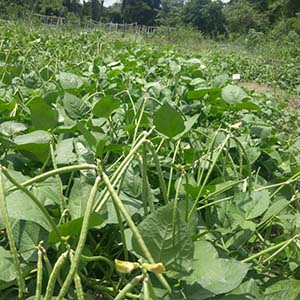The impact of climate change on the productivity of cowpea (Vigna unguiculata) under three different socio-economic pathways

Accepted: 21 November 2022
Appendix: 72
HTML: 48
All claims expressed in this article are solely those of the authors and do not necessarily represent those of their affiliated organizations, or those of the publisher, the editors and the reviewers. Any product that may be evaluated in this article or claim that may be made by its manufacturer is not guaranteed or endorsed by the publisher.
Crop models are useful tools for simulating the impact of climate change on crop growth, development and yield. This study assesses the impact of climate change on cowpea yield in soils with low levels of phosphorous content mainly in the Sudan Savanna and Forest Transition Zone of West Africa. A crop model solution within the general modelling framework SIMPLACE in combination with the output of four climate models for 3 contrasting shared socio-economic scenarios (SSP126, SSP370, and SSP585) was used to simulate the impact of climatic change on phenology, above ground biomass and yield parameters of cowpea. The simulations were carried out for Ouagadougou and Kumasi, representing the two major savanna biomes in West Africa (Sudan Savanna and Guinea Savanna). Previous field experimental data on the wide-spread cowpea genotype Asontem from a P-deficient soil at Kumasi (Ghana) were used to validate the SIMPLACE crop model solution. The model was able to simulate the impact of irrigation and fertilizer management on cowpea growth and yield assessment with adequate accuracy. Compared to historic simulations of the biomass and yield of cowpea, the model solution projected higher above ground biomass, and yield under the pre-dominant low input cropping systems for all the three SSPs as a result of the rise in CO2 and in spite of slightly shorted growing cycle length in both locations.
Highlights
- SIMPLACE crop model solution can reproduce cowpea yields for contrasting irrigation and fertilizer management.
- Compared to the baseline period, the model projected for the future period (2040 to 2070) slightly higher cowpea yields under three different socio-economic pathways.
- Cowpea biomass and yield remained high in future climate scenarios, despite slightly shorted growing cycle length, because of the rise in CO2.
- The projected trends have been similar in the Sudan and in the Guinea Savanna of West Africa.
How to Cite

This work is licensed under a Creative Commons Attribution-NonCommercial 4.0 International License.
PAGEPress has chosen to apply the Creative Commons Attribution NonCommercial 4.0 International License (CC BY-NC 4.0) to all manuscripts to be published.

 https://doi.org/10.4081/ija.2022.2118
https://doi.org/10.4081/ija.2022.2118



